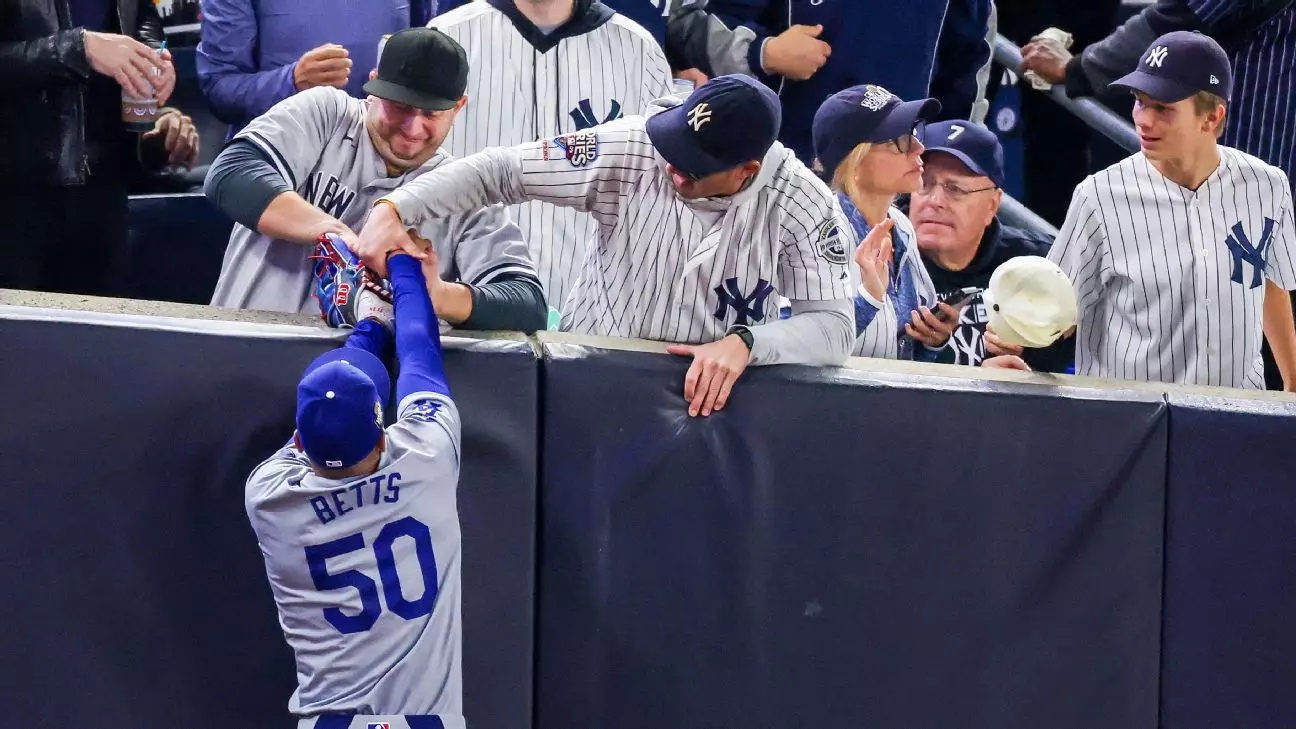In a moment that shocked the baseball community, two fervent New York Yankees fans were barred from attending a crucial Game 5 of the World Series due to their blatant interference with Los Angeles Dodgers star Mookie Betts during Game 4. The Yankees organization made headlines with their firm stance on the issue, declaring in a public statement that the behavior exhibited by these fans was both “egregious and unacceptable.” Such incidents raise essential questions about player safety and the boundaries of fan engagement, compelling a closer examination of the increasingly blurred lines in sportsmanship and fandom.
The fans in question, Austin Capobianco and John Peter, found themselves at the center of this controversy after attempting to retrieve a baseball from Betts’ glove during his spectacular first-inning catch. Their aggressive actions not only drew the ire of the players involved but also ignited a discussion about the necessary parameters for enjoying live sports events. With live sports evoking strong emotions, it is crucial to maintain an environment that prioritizes safety for players, fans, and staff alike.
Consequences and Reactions
The consequences of this incident were swift and severe. The Yankees took immediate action by revoking the tickets of Capobianco and Peter and even transferring their Game 5 tickets to a child battling illness, who was unable to attend an earlier event due to their condition. This gesture highlights a prioritization of values beyond mere entertainment in sports, emphasizing compassion and ethical fan behavior over entitlement and impulsiveness.
Capobianco expressed disappointment, stating that the organization’s decision, while justifiable, places their long-term season ticket ownership in jeopardy. This serves to underscore the precarious position amateur fans sometimes find themselves in—caught between their passionate support for their teams and the need to respect the inherent integrity of the game. The incident has sparked a broader conversation on the responsibilities that come with being a fan and the potential implications of crossing the line into reckless behavior.
Tony Clark, executive director of the Major League Baseball Players Association, further emphasized the gravity of the situation, reiterating that player safety must always be a top priority. The league’s commitment to maintaining a secure environment for all individuals at the ballpark is crucial, particularly given incidents where fan behavior might escalate into a physical confrontation. It is clear that while passionate fans are a hallmark of the game, their enthusiasm must never come at the expense of players’ well-being.
The league’s response also underscores a need for robust protocols to prevent similar occurrences in the future. Increased monitoring, strict enforcement of stadium rules, and enhanced security measures should be at the forefront of discussions aimed at protecting players and ensuring respectful interaction between fans and athletes. Expectations should be set: to cheer and celebrate the sport, but to never infringe upon the safety of those on the field.
New York Yankees’ left fielder Alex Verdugo’s comments hint at a deeper, cultural dimension surrounding sports fandom. He suggested that such intense actions are somewhat representative of the passionate New York sports culture, emphasizing how the city’s fervor can occasionally lead to extreme behavior among supporters. However, it is essential to question whether such cultural associations should be accepted or regarded as a rationale for boundary-pushing actions that could jeopardize player safety.
Indeed, the dynamics at play in this incident highlight a larger trend in fandom—fans often feel a strong connection to their teams and players, which can manifest in both positive and negative behaviors. It raises the question: should the emotional investment that fans have in their teams permit them to engage in disrespectful acts towards players, regardless of location? Finding that balance between passionate support and responsible behavior is critical.
The actions of Austin Capobianco and John Peter serve as a stark reminder of the thin line that exists between enthusiastic support and overstepping boundaries in the realm of sports. The fallout from this incident may have lasting effects, not only for the individuals involved but also for the overarching discourse regarding fan behavior and player safety. While the energy of fandom plays an essential role in vibrant sporting events, it must always be grounded in respect and integrity. As both fans and athletes navigate this evolving landscape, it is imperative to reinforce the notion that admiration and support should enhance the sports experience, without compromising safety or decency within the arena of competition.


Leave a Reply